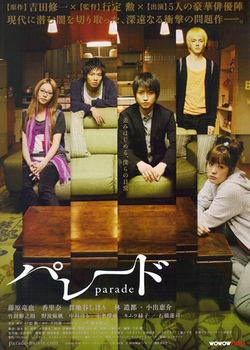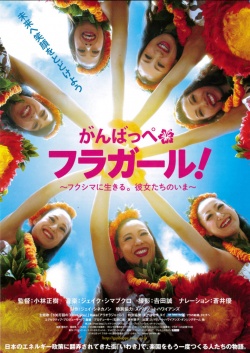Eiga Sai 2013: Japanese Film Festival
Monday, July 08, 2013
I miss watching Eiga Sai and I hope I can get to watch it again over the week, hosted by Japan Foundation Manila in cooperation with the Embassy of Japan, top lifestyle hub Shangri-La Plaza, and the Film Development Council of the Philippines, Eiga Sai will be available for free to the public from July 4 to 14, at Cinema 2 of the Shang Cineplex.
Seats are on a first-come, first served basis. Tickets are released 30 minutes before the screening. Film ratings may be confirmed at the ticket office.
For inquiries, contact 370-2597 or 370-2598 or log on to www.shangrila-plaza.com. Add Shangri-La Plaza on Facebook: shangrilaplazaofficialfanpage.
The film fest kicks off with the screening of "About Her Brother", filmmaker Yamada Yoji’s homage to legendary director Ichikawa Kon's film of the same title. The movie presents a heartwarming story of the bond between a hard-working older sister Koharu and her long lost younger brother Tetsuro.
Remaining Schedule are as follows:
July 9, 2013 (Tuesday)
Mai Mai Miracle - 1:30PM
ALWAYS-Sunset on Third Street - 4:30PM
Parade - 7:30PM
July 10, 2013 (Wednesday)
Japan, Our Homeland - 1:30PM
About Her Brother - 4:30PM
ALWAYS-Sunset on Third Street 2 - 7:30PM
July 11, 2013 (Thursday)
ALWAYS-Sunset on Third Street 3 - 1:30PM
Rinco's Restaurant - 4:30PM
Confessions - 7:30PM
July 12, 2013 (Friday)
Castle Under Fiery Skies - 1:30PM
Parade - 4:30PM
Dear Doctor - 7:30PM
July 13, 2013 (Saturday)
Mai Mai Miracle - 1:30PM
ALWAYS-Sunset on Third Street 2 - 4:30PM
KAMUI - 7:30PM
July 14, 2013 (Sunday)
ALWAYS-Sunset on Third Street - 1:30PM
Rinco's Restaurant - 4:30PM
ALWAYS-Sunset on Third Street 3 - 7:30PM
Check out the synopsis of the movies below:

About Her Brother
Master filmmaker Yamada Yoji, known for his humanistic films, directs his first contemporary feature in ten years. Paying homage to Ichikawa Kon’s film of the same title,the film presents a heartwarming depiction of the bond between a hard-working older sister and her younger brother, a failed performer. Widowed young, Ginko (Yoshinaga Sayuri) runs a pharmacy and lives with her daughter, Koharu (Aoi Yu), and her motherin-law, Kinuyo (Kato Haruko). Koharu was to marry a distinguished doctor; and, out of the blue, Ginko’s long lost brother, Tetsuro (Shofukutei Tsurube), showed up drunk at the wedding; thus, ruined the occasion
ALWAYS-Sunset on Third Street
Set in a working class district of Tokyo in 1958, the year when the Tokyo Tower was built. Norifumi (Tsutsumi Shinichi) runs a garage in Yuuhi-machi 3-chome. A woman named Mutsuko comes to the garage to work, but she is disappointed to find out that it is such a small place. Norifumi’s son, Ippei, cheers her up by telling her that they are getting a TV at home soon. Meanwhile, the owner of the Sweet Shop opposite the garage, Chagawa (Yoshioka Hidetaka) drunkenly agrees to look after a boy named Junnosuke. Yuuhi-machi 3-chome welcomes the two new inhabitants. Everyone is in a festive mood with the coming of TV, Christmas and other good news. The years roll by, then Junnosuke’s father turns up in town. There is already a strong bond between Chagawa and Junnosuke, but Chagawa, thinking about the boy’s future, sends him off with his father

ALWAYS-Sunset on Third Street 2
A sequel to ALWAYS -Sunset on Third Street (ALWAYS Sancho-me no Yuhi), an empathic drama set in the Showa era. Direction, script and VFX are again by Yamazaki Takashi, as in the first part. The full use of VFX to realistically recreate the street scenes of the Showa era was well talked about in the first part. This sequel shows Nihombashi and Haneda airport recreated as in those days.Spring of 1959. Chagawa (Yoshioka Hidetaka) still thinks of Hiromi (Koyuki) who took off without a word, while living with Junnosuke(Suga Kenta), a boy Hiromi left in his care. At Suzuki Auto, where Suzuki Norifumi (Tsutsumi Shinichi) and his wife Tomoe (Yakushimaru Hiroko) live, Mutsuko (Horikita Maki) is established enough to be on her own. Then the Suzukis gain a new family member - their relatives’ daughter whom they are going to look after. As for Chagawa, Junnosuke’s biological father, Kawabuchi, comes to take back his son. In order to keep Junnosuke with him, the father imposes conditions upon him to give the boy a decent life. To secure a stable life and to prove himself to Hiromi, Chagawa starts writing again to win the Akutagawa award, a once abandoned hope

ALWAYS-Sunset on Third Street 3
The third installment in a popular comedy-drama series following the lives of residents of a Tokyo neighborhood, this time taking place in 1964. Shot using the same 3D system as James Cameron’s Avatar, it vividly evokes the vitality of the times by interspersing nostalgic CG recreations of the Tokyo olympics, the bullet train soon after it went into operation, and a lot more. As the benefits of Japan’s economic boom were being felt on Third Street in Sunset Town, unfortunate incidents were taking place—novelist Chagawa (Yoshioka Hidetaka) finds himself upstaged by a younger writer and ironically falls into a slump. Then he receives word from his family in Nagano that his father is seriously ill

Confessions
Nakashima Tetsuya, director of Kamikaze Girls (Shimotsuma Monogatari) and Memories of MATSUKO (Kiraware Matsuko no Issho) discards his distinctive flashy and comical style and ventures into new territory with this more somber piece, based on Minato Kanae’s mystery novel. The film has been selected as Japan’s entry for the 83rd Academy Awards’ Foreign Language Film. Moriguchi Yuko (Matsu Takako) is a junior high school teacher who has lost a daughter. She has reason to believe that the murderer is among her students so she announces to the class her intentions to avenge her daughter’s death. A punishment beyond anyone’s imagination awaits the killer...

Castle Under Fiery Skies
The story takes place in 1576. After defeating his greatest enemy, the Takeda clan, in the Battle of Nagashino in 1575, Oda Nobunaga (Kippei Shiina) aspires to build an enormous castle on Mount Azuchi, overlooking Lake Biwa, as a symbol of his efforts to unite the country. As architect and chief master of the project, Nobunaga chooses Mataemon Okabe (Toshiyuki Nishida), a temple carpenter from Atsuta. The construction steadily advances under Mataemon’s guidance. However, the path to completion of the greatest castle of all time is mined with obstacles

Japan, Our Homeland
In the late 1950s, Japan was in a state of recovery from the ravages of the war—developing its economy. In downtown Tokyo, children always played outdoors until sunset and were awaited warmly at home by their families. Akira is an ordinary boy—naïve and serious; Gon is the boss; and, Hakase is a genius. One spring, a new female music teacher and a pretty girl—Shizu, who likes to sing join their class. They decide to join a singing competition in school; ‘DOYO’ (Japanese children’s songs) was their choice and they practice well. However, some boys in the school are found shoplifting; as a result, the class is forced to withdraw from the singing competition… But somehow, Akira and his classmates try to re-enter the competition. There was a strong will to realize Ms. Sakamoto’s wish and Shizu’s dream to become a singer.

Light Up Nippon - Recovery From The Great East Japan Earthquake
On March 11, 2011, Japan was hit by an unprecedented earthquake and tsunami that caused great devastation to property and loss of lives in the Tohoku region; the entire nation was consequently in grief. LIGHT UP NIPPON is a fireworks display project launched in 10 disaster-stricken areas simultaneously following the Great East Japan Earthquake. After overcoming many obstacles with strong commitment and sheer determination, the first fireworks event was on August 11, 2011, much to the delight of many people—it was a memorial for the victims and a symbol of hope for recovery. The Japan Foundation has produced a documentary video for overseas viewing that includes the LIGHT UP NIPPON project, which was made possible through the efforts of individuals from Japan’s younger generation

Dear Doctor
The third film from Nishikawa Miwa, whose previous film Sway garnered many domestic film awards and gained attention at the Cannes film festival. A novel she herself wrote, bated on the idea of this film, was nominated for the Naoki Prize. This sincere, humanistic drama takes a scalpel to the timely theme of rural medical treatment against a beautiful pastoral backdrop. Rakugo storyteller Shofukutei Tsurube, gives a highly empathetic performance in his first lead role, as a medical practitioner (Dr. Ino) beloved by the mountain village residents. Dr. Ino suddenly vanishes after meeting with a terminal patient; and, his identity puzzled the villagers

Kamui
Director/screenwriter Sai Yoichi and screenwriter Kudo Kankuro have created a live action period piece based on the internationally famous classic Ninja comic by Shirato Sampei. Kamui (Matsuyama Kenichi), born in the 17th century in the lower classes of society, became a Ninja in order to survive. Unable to bear the restrictive rules and brutality, he fled—known as an escaped Ninja. Being a fugitive, he lived in the home of fisherman Hanbei (Kobayashi Kaoru) whose life he saved. Hanbei’s wife Sugaru (Koyuki)—herself an escaped Ninja did not trust him. Meanwhile, Hanbei’s daughter Sayaka (Ohgo Suzuka) finds herself falling in love with him

Parade
A dark coming-of-age ensemble piece adapted from Yoshida Shuichi’s novel, which won the Yamamoto Shugoro Prize. Appraised for his portrayal of restless and apathetic youth, director Yukisada Isao depicts how repeated incidents of violent assault cast a shadow on the superficial relationship between a group of five young men and women. Film production employee Naoki (Fujiwara Tatsuya), struggling illustrator Mirai (Karina), part-timer Kotomi (Kanjiya Shihori), and college student Ryosuke (Koide Keisuke) share an apartment. Their seemingly peaceful communal life starts to go awry when a male prostitute, Satoru (Hayashi Kento), comes into their lives

Mai Mai Miracle
Nostalgic full length animated film adaptation of the autobiographical novel of the same title by Akutagawa Prize winner, Takagi Nobuko. Set in Hofu City, Yamaguchi Prefecture in the mid 1950’s, a place which still retains historic sites and placenames of the Heian period. The film portrays the warm friendship between a young local girl (Shinko) with a rich imagination, and a girl (Kiiko) who came from Tokyo. Production house MADHOUSE (The Girl Who Leapt Through Time; Summer Wars), completed the film using visually pleasing graphics. Shinko (voiced by Fukuda Mayuko) is an energetic third-grader who has a curl in her forehead that she calls her “Mai Mai.” She loves listening to her grandfather’s stories of the Heian period, and finds herself imaging the lives of those who lived 1000 years ago. When Kiiko (voiced by Mizusawa Nako) came, the ever-curious Shinko finds Kiiko’s unfamiliarity with the local ways to be fascinating. They become fast friends, and spent much time together. They started on a project to stop the canals and build a dammed lake; and, taking care of a goldfish they had discovered.

Wanko - The Story of Me, My Family and My Dog
Miyakejima, a small island in the Pacific Ocean, is a six-and-a-half hour boat ride away from Tokyo. There have been eruptions every 20 years on this volcanic island. Here, the Noyama family runs a guesthouse in the sixth district. Shin, a primary school pupil, adores a newborn puppy that he has named Rock. In August 2000, Mount Oyama in Miyakejima erupts violently, forcing the Noyama family to evacuate. At that time, Rock goes missing. One day, Shin and his family miraculously reunite with Rock at a volcanic hazard animal rescue center. However, dogs are not allowed at the shelter. Rock, already not well, becomes increasingly weak, and the family members do not know when they will return to the island. In this situation fraught with anxieties and conflicts, Shin makes a decision.

Fukushima Hula Girls
This documentary was produced after the Great East Japan Earthquake in March 11, 2011. Iwaki City, one of the hardest-hit areas close to the Fukushima nuclear power plant, features the beautiful “Spa Resort Hawaiians” resort hotel and facilities. After the disaster, everyone working at the resort, including the hula dancers known as the “Hula Girls,” has been trying to overcome the challenges of rebuilding the facility as a first step toward the reconstruction of Fukushima. The film tells the story of these people facing everyday life and other struggles leading up to the reopening of “Spa Resort Hawaiians.”

Rinco's Restaurant
A heartwarming human drama based on lyricist Ogawa Ito’s debut novel. Using CG animation and musical scenes, this fantastical film shows us the small miracles a little heartfelt cooking can bring. In shock from a heart break, Rinco (Shibasaki Kou) has lost her voice. She reluctantly moves in with her himsical mother Ruriko (Yo Kimiko), but trying to find a way to provide for herself, she decides to convert the guest house into a restaurant, where she serves only one pair of guests a day with carefully cooked meals. Soon word spreads that “dining there will bring you happiness.”

Haru's Journey
In April 2009, an elderly man named Tadao and his granddaughter Haru go on a trip. Tadao, living in the lonely fishing village of Mashike in Hokkaido, had spent his life fishing for Pacific herring. Retired after injuring his leg, he lives with Haru after his only daughter killed herself. While taking care of her grandfather, Haru worked as a nutritionist, but lost her job when the elementary school that employed her closed down. One day, Haru tells Tadao that she wants to move to the city to find a new job and that one of his siblings should look after him. Tadao gets angry but has no choice; they set off to visit his estranged siblings in Tohoku in northeastern Japan. Their journey consequently revolves around the theme of family reconciliation, as Haru and Tadao come to understand the harshness of life and how precious human relations are. Thus, Tadao looks back on his life and Haru finds a new future.

Brave Story
Based on a fantasy masterpiece by best selling author, Miyabe Miyuki. A primary school pupil, Wataru, lives with his mother as his parents are divorced. His mother slips into critical condition. “If you go to the other side of that door, you can change your fate,” says his new classmate, Mitsuru. Mitsuru came to the world of Vision before Wataru. Wataru follows the advice of Mitsuru and sets off on a journey into the world of Vision. Wataru becomes a trainee hero, and travels in search of a hidden treasure that has the power to change fate. Entrusted with fate, Wataru chooses to prioritize peace in Vision over his wish to recover his happy home with his parents. The demons are sealed away and peace returns to Vision once again.














0 comments